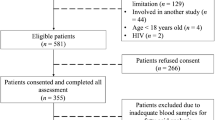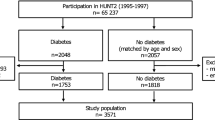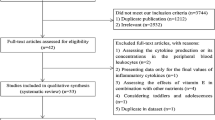Abstract
Background/objectives:
We examined the prevalence of elevated plasma high-sensitivity C-reactive protein (hs-CRP) concentrations and associations with red blood cell (RBC) long-chain n-3 polyunsaturated fatty acids (LCn-3PUFA) in the James Bay Cree population from the province of Quebec (Canada).
Subjects/methods:
A total of 744 Cree adults (18–91 years) from seven communities of Eastern James Bay were included in these cross-sectional analyses. Associations between RBC LCn-3PUFA and proinflammatory markers (hs-CRP, interleukin-6 (IL-6) and tumor necrosis factor-alpha (TNF-α)) were assessed by using multivariate general linear models with adjustment for sex, age and waist circumference. An arbitrary inflammation score was defined based on the sum of the quartiles of hs-CRP, IL-6 and TNF-α concentrations (range=3–12).
Results:
Elevated hs-CRP concentrations (>3 mg/l) were present in 46.9% (95% confidence interval (CI) 43.3–50.5) of the James Bay Cree population. RBC docosapentaenoic acid (DPAn-3; C22:5n-3) was inversely associated with hs-CRP, TNF-α and the inflammation score (all P trend<0.02), whereas eicosapentaenoic acid (C20:5n-3) and docosahexaenoic acid (C22:6n-3) in RBC were not associated with inflammation (all P trend>0.18). Among participants with RBC DPAn-3 levels above the median of the population, odds ratio of having an elevated inflammation score (⩾9) was 0.67 (95% CI, 0.48–0.93) compared with participants below the median.
Conclusions:
Results indicate that low-grade systemic inflammation is highly prevalent and that higher RBC DPAn-3 levels are associated with a lower risk of systemic inflammation in the James Bay Cree population.
This is a preview of subscription content, access via your institution
Access options
Subscribe to this journal
Receive 12 print issues and online access
$259.00 per year
only $21.58 per issue
Buy this article
- Purchase on Springer Link
- Instant access to full article PDF
Prices may be subject to local taxes which are calculated during checkout

Similar content being viewed by others
References
Haman F, Fontaine-Bisson B, Batal M, Imbeault P, Blais JM, Robidoux MA . Obesity and type 2 diabetes in Northern Canada's remote First Nations communities: the dietary dilemma. Int J Obes (Lond) 2010; 34(Suppl 2): S24–S31.
Garriguet D . Obesity and the eating habits of the Aboriginal population. Health Rep 2008; 19: 21–35.
Dannenbaum D, Kuzmina E, Lejeune P, Torrie J, Gangbe M . Prevalence of diabetes and diabetes-related complications in First Nations communities in northern Quebec (Eeyou Istchee), Canada. Can J Diabetes 2008; 32: 46–52.
Shah BR, Hux JE, Zinman B . Increasing rates of ischemic heart disease in the native population of Ontario, Canada. Arch Intern Med 2000; 160: 1862–1866.
Young TK, Reading J, Elias B, O'Neil JD . Type 2 diabetes mellitus in Canada's first nations: status of an epidemic in progress. CMAJ 2000; 163: 561–566.
Scrivo R, Vasile M, Bartosiewicz I, Valesini G . Inflammation as ‘common soil’ of the multifactorial diseases. Autoimmun Rev 2011; 10: 369–374.
Connelly PW, Hanley AJ, Harris SB, Hegele RA, Zinman B . Relation of waist circumference and glycemic status to C-reactive protein in the Sandy Lake Oji-Cree. Int J Obes (Lond) 2003; 27: 347–354.
Anand SS, Razak F, Yi QL, Davis B, Jacobs R, Vuksan V et al. C-reactive protein as a screening test for cardiovascular risk in a multiethnic population. Arterioscler Thromb Vasc Biol 2004; 24: 1509–1515.
Imbeault P, Findlay CS, Robidoux MA, Haman F, Blais JM, Tremblay A et al. Dysregulation of cytokine response in Canadian First Nations communities: is there an association with persistent organic pollutant levels? PLoS One 2012; 7: e39931.
Liu J, Young TK, Zinman B, Harris SB, Connelly PW, Hanley AJ . Lifestyle variables, non-traditional cardiovascular risk factors, and the metabolic syndrome in an Aboriginal Canadian population. Obesity (Silver Spring) 2006; 14: 500–508.
Lopez-Garcia E, Schulze MB, Manson JE, Meigs JB, Albert CM, Rifai N et al. Consumption of (n-3) fatty acids is related to plasma biomarkers of inflammation and endothelial activation in women. J Nutr 2004; 134: 1806–1811.
Zampelas A, Panagiotakos DB, Pitsavos C, Das UN, Chrysohoou C, Skoumas Y et al. Fish consumption among healthy adults is associated with decreased levels of inflammatory markers related to cardiovascular disease: the ATTICA study. J Am Coll Cardiol 2005; 46: 120–124.
He K, Liu K, Daviglus ML, Jenny NS, Mayer-Davis E, Jiang R et al. Associations of dietary long-chain n-3 polyunsaturated fatty acids and fish with biomarkers of inflammation and endothelial activation (from the Multi-Ethnic Study of Atherosclerosis [MESA]). Am J Cardiol 2009; 103: 1238–1243.
Micallef MA, Munro IA, Garg ML . An inverse relationship between plasma n-3 fatty acids and C-reactive protein in healthy individuals. Eur J Clin Nutr 2009; 63: 1154–1156.
Farzaneh-Far R, Harris WS, Garg S, Na B, Whooley MA . Inverse association of erythrocyte n-3 fatty acid levels with inflammatory biomarkers in patients with stable coronary artery disease: The Heart and Soul Study. Atherosclerosis 2009; 205: 538–543.
Reinders I, Virtanen JK, Brouwer IA, Tuomainen TP . Association of serum n-3 polyunsaturated fatty acids with C-reactive protein in men. Eur J Clin Nutr 2012; 66: 736–741.
Kalogeropoulos N, Panagiotakos DB, Pitsavos C, Chrysohoou C, Rousinou G, Toutouza M et al. Unsaturated fatty acids are inversely associated and n-6/n-3 ratios are positively related to inflammation and coagulation markers in plasma of apparently healthy adults. Clin Chim Acta 2010; 411: 584–591.
Mozaffarian D, Lemaitre RN, King IB, Song X, Spiegelman D, Sacks FM et al. Circulating long-chain omega-3 fatty acids and incidence of congestive heart failure in older adults: the cardiovascular health study: a cohort study. Ann Intern Med 2011; 155: 160–170.
Ferrucci L, Cherubini A, Bandinelli S, Bartali B, Corsi A, Lauretani F et al. Relationship of plasma polyunsaturated fatty acids to circulating inflammatory markers. J Clin Endocrinol Metab 2006; 91: 439–446.
Makhoul Z, Kristal AR, Gulati R, Luick B, Bersamin A, Boyer B et al. Associations of very high intakes of eicosapentaenoic and docosahexaenoic acids with biomarkers of chronic disease risk among Yup'ik Eskimos. Am J Clin Nutr 2010; 91: 777–785.
Makhoul Z, Kristal AR, Gulati R, Luick B, Bersamin A, O'Brien D et al. Associations of obesity with triglycerides and C-reactive protein are attenuated in adults with high red blood cell eicosapentaenoic and docosahexaenoic acids. Eur J Clin Nutr 2011; 65: 808–817.
Dewailly E, Blanchet C, Gingras S, Lemieux S, Holub BJ . Cardiovascular disease risk factors and n-3 fatty acid status in the adult population of James Bay Cree. Am J Clin Nutr 2002; 76: 85–92.
Dewailly E, Blanchet C, Gingras S, Lemieux S, Holub BJ . Fish consumption and blood lipids in three ethnic groups of Quebec (Canada). Lipids 2003; 38: 359–365.
Sun Q, Ma J, Campos H, Hankinson SE, Hu FB . Comparison between plasma and erythrocyte fatty acid content as biomarkers of fatty acid intake in US women. Am J Clin Nutr 2007; 86: 74–81.
Vidgren HM, Agren JJ, Schwab U, Rissanen T, Hanninen O, Uusitupa MI . Incorporation of n-3 fatty acids into plasma lipid fractions, and erythrocyte membranes and platelets during dietary supplementation with fish, fish oil, and docosahexaenoic acid-rich oil among healthy young men. Lipids 1997; 32: 697–705.
Katan MB, Deslypere JP, van Birgelen AP, Penders M, Zegwaard M . Kinetics of the incorporation of dietary fatty acids into serum cholesteryl esters, erythrocyte membranes, and adipose tissue: an 18-month controlled study. J Lipid Res 1997; 38: 2012–2022.
Valera B, Dewailly E, Poirier P . Impact of mercury exposure on blood pressure and cardiac autonomic activity among Cree adults (James Bay, Quebec, Canada). Environ Res 2011; 111: 1265–1270.
Ridker PM . Clinical application of C-reactive protein for cardiovascular disease detection and prevention. Circulation 2003; 107: 363–369.
Nieboer E, Dewailly E, Egeland GM, Château-Degat M-L, Bonnier-Viger Y . Nituuchischaayihtitaau Aschii. Multi-Community Environment-and-Health Longitudinal Study in Eeyou Istchee: Eastmain and Wemindji. Technical report: summary of 2007 activities, results and recommendations. In: Nieboer E, Robinson E, Petrov K (eds). Public Health Report Series 4 on the Health of the Population. Cree Board of Health and Social Services of James Bay: Chisasibi, QC, Canada, 2011.
Alberti KGMM, Zimmet P, Shaw J . The metabolic syndrome - a new worldwide definition. Lancet 2005; 366: 1059–1062.
Pirro M, Bergeron J, Dagenais GR, Bernard PM, Cantin B, Despres JP et al. Age and duration of follow-up as modulators of the risk for ischemic heart disease associated with high plasma C-reactive protein levels in men. Arch Intern Med 2001; 161: 2474–2480.
Sampasa-Kanyinga H, Levesque B, Anassour-Laouan-Sidi E, Cote S, Serhir B, Ward BJ et al. Zoonotic infections in native communities of James Bay, Canada. Vector Borne Zoonotic Dis 2012; 12: 473–481.
International Physical Activity Questionnaire (IPAQ). Guidelines for Data Processing and Analysis of the International Physical Activity Questionnaire (IPAQ) – Short and Long Forms November 2005. Available from http://www.ipaq.ki.se/scoring.pdf (accessed 23 July 2013).
Pearson TA, Mensah GA, Alexander RW, Anderson JL, Cannon RO, Criqui M et al. Markers of inflammation and cardiovascular disease application to clinical and public health practice - A statement for healthcare professionals from the centers for disease control and prevention and the American Heart Association. Circulation 2003; 107: 499–511.
Labonte ME, Dewailly E, Chateau-Degat ML, Couture P, Lamarche B . Population-based study of high plasma C-reactive protein concentrations among the Inuit of Nunavik. Int J Circumpolar Health 2012; 71: 19066.
Bruunsgaard H, Pedersen M, Pedersen BK . Aging and proinflammatory cytokines. Curr Opin Hematol 2001; 8: 131–136.
Sun Q, Ma J, Campos H, Rexrode KM, Albert CM, Mozaffarian D et al. Blood concentrations of individual long-chain n-3 fatty acids and risk of nonfatal myocardial infarction. Am J Clin Nutr 2008; 88: 216–223.
Rowley K, Walker KZ, Cohen J, Jenkins AJ, O'Neal D, Su Q et al. Inflammation and vascular endothelial activation in an Aboriginal population: relationships to coronary disease risk factors and nutritional markers. Med J Aust 2003; 178: 495–500.
Mozaffarian D, Wu JH . (n-3) fatty acids and cardiovascular health: are effects of EPA and DHA shared or complementary? J Nutr 2012; 142: 614S–625S.
Kaur G, Cameron-Smith D, Garg M, Sinclair AJ . Docosapentaenoic acid (22:5n-3): a review of its biological effects. Prog Lipid Res 2011; 50: 28–34.
Borgeson E, Godson C . Resolution of inflammation: therapeutic potential of pro-resolving lipids in type 2 diabetes mellitus and associated renal complications. Front Immunol 2012; 3: 318.
Potischman N . Biologic and methodologic issues for nutritional biomarkers. J Nutr 2003; 133(Suppl 3): 875S–880S.
Acknowledgements
One of the primary authors of this research, Dr Eric Dewailly, died tragically in an accident on 17 June 2014, while on vacation in La Réunion with his family. Dr Dewailly was one of the leading figures in public and environmental health research in Canada and worldwide. His contributions to the study of contaminants and their impact on health among First Nations are among his numerous legacies. Dr Dewailly was passionate not only in research but also in life, being immensely appreciated by colleagues and friends. His leadership and engaging personality will be missed.
This is a report from the Nituuchischaayihtitaau Aschii Multi-Community Environment and Health Study in Iiyiyiu Aschii supported by the Cree people of northern Quebec, the Cree First Nations and the Cree Board of Health and Social Services of James Bay (CBHSSJB) through financial contributions from Niskamoon Corporation. Niskamoon Corporation had no role in the design and conduct of the study; the collection, analysis and interpretation of the data; or in the preparation, review or approval of the manuscript. The CBHSSJB was involved in the design and conduct of the study and the review and approval of the manuscript. We thank the coordinators, nurses, interviewers and other staff persons who worked at each stage of the survey process. We are also grateful to all study participants. Marie-Eve Labonté is recipient of doctoral scholarships from the Canadian Institutes of Health Research (CIHR) and the Fonds de recherche du Québec–Santé (FRQS) and of a scholarship from the CBHSSJB through Niskamoon Corporation for the present work.
Author contributions
Éric Dewailly designed the research and collected data; Marie-Éve Labonté performed statistical analyses, interpreted the data and wrote the manuscript; Benoît Lamarche, Michel Lucas and Patrick Couture participated in the analysis and interpretation of data; Benoît Lamarche has had full access to the data in the study and has primary responsibility for the final content of the paper. All authors critically reviewed the manuscript and approved its final version.
Author information
Authors and Affiliations
Corresponding author
Ethics declarations
Competing interests
Marie-Eve Labonté has received funding from the Cree Board of Health and Social Services of James Bay (CBHSSJB) through Niskamoon Corporation for the present work. The other authors declare no conflict of interest.
Additional information
Supplementary Information accompanies this paper on European Journal of Clinical Nutrition website
Supplementary information
Rights and permissions
About this article
Cite this article
Labonté, MÈ., Dewailly, É., Lucas, M. et al. Association of red blood cell n-3 polyunsaturated fatty acids with plasma inflammatory biomarkers among the Quebec Cree population. Eur J Clin Nutr 68, 1042–1047 (2014). https://doi.org/10.1038/ejcn.2014.125
Received:
Revised:
Accepted:
Published:
Issue Date:
DOI: https://doi.org/10.1038/ejcn.2014.125



